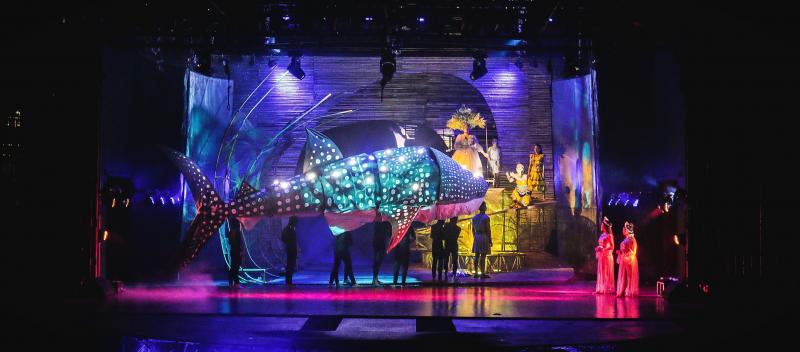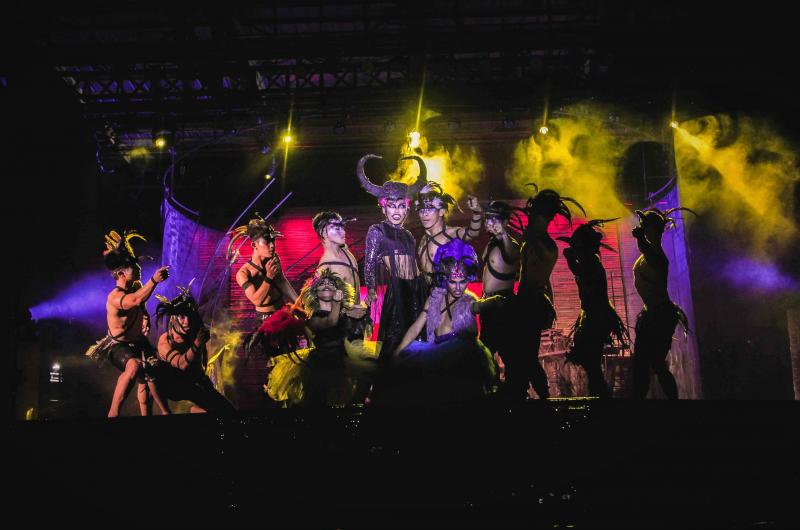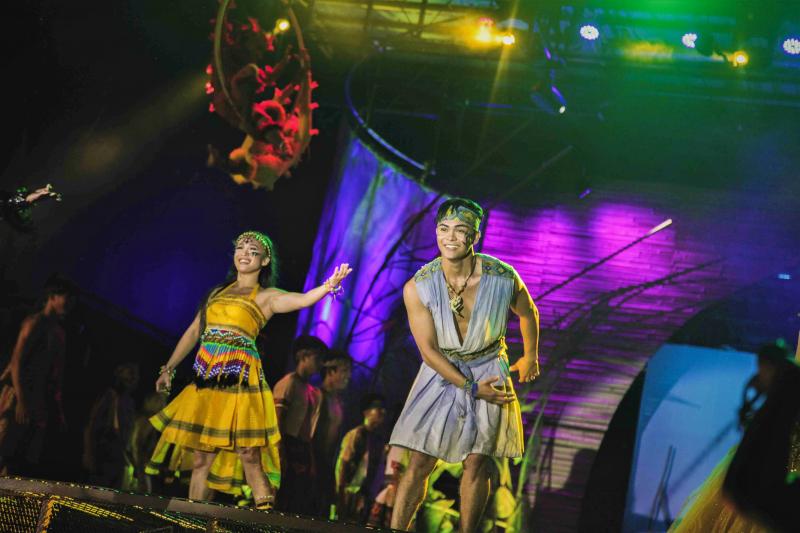Review: NIA AND ANWAR Takes Your Average Theme Park Experience to a Whole New Level

Dapitan City, Zamboanga Del Norte--With elaborate props and costumes, crowd-pleasing acrobatics and fire dances, "Nia and Anwar and the Whale Shark Tale" is a daring new Filipino musical that might possibly be the first-of-its-kind in the southern Philippines. Performed on an open-air stage at Gloria's Fantasyland, a theme park in Dapitan City, this one-act show is packed with surprises, taking your average theme park experience to a whole new level.
This musical tells a fictional story (concept by the show's producer Romeo G. Jalosjos) about how the whale shark, referred to by locals as butanding, came into being. This sea creature (categorically a shark but has the body of a whale) is characterized by its wide mouth and white spots all over its body. The answer to the question (how it came to exist) is addressed by way of an adventure-driven story with a touch of romance, typical of folklores that Filipinos often hear from their ancestors.
 The show's book and libretto, by thespian Cathy Azanza Dy, are easy to follow and bear some glaring similarities with some popular musicals. In the show's opening number, when the villagers on the island of Minta burst into an energetic song-and-dance number honoring the Sun Goddess, Rahna, we are reminded of the song "We Dance" from the Broadway musical "Once on This Island" (interestingly, a show Dy previously did). Donned in an elaborate yellow gown, Rahna, played by Lana Jalosjos (Misty Wathskin, Princess AJ Jamarolin, and Danika Dimasuhid at certain performances), appears on stage with her Cape of Stars, a lavishly-beaded garment that is meant to guide the voyagers on their way back to the island during night time.
The show's book and libretto, by thespian Cathy Azanza Dy, are easy to follow and bear some glaring similarities with some popular musicals. In the show's opening number, when the villagers on the island of Minta burst into an energetic song-and-dance number honoring the Sun Goddess, Rahna, we are reminded of the song "We Dance" from the Broadway musical "Once on This Island" (interestingly, a show Dy previously did). Donned in an elaborate yellow gown, Rahna, played by Lana Jalosjos (Misty Wathskin, Princess AJ Jamarolin, and Danika Dimasuhid at certain performances), appears on stage with her Cape of Stars, a lavishly-beaded garment that is meant to guide the voyagers on their way back to the island during night time.
Nia, played by Alma Reina Sarita (alternating with Mae Angelica Caidic, Danika Dagooc, and Lady Rose Alia) and voiced by Caisa Borromeo, is tasked to guard this cape, which happens to be within reach once one is on top of a very high mountain. As what we come to expect in legends of this nature, the careless and stubborn Nia is outwitted by the trickster god, Daawe, played by Cydrimen Millan (Noriel Obnimaga and Dexter Gerbolingo are alternates) and voiced by Noel Rayos, who is keen on stealing the cape in order for him to overthrow Rhana as the ruler of night and day. To redeem her integrity as the village's trustworthy warrior, Nia devises a plan, together with her best friend Anwar, played by Mark Jason Java (at certain performances, Jaynel Omaguing) and voiced by Reb Atadero, to retrieve back the cape from Daawe. How the butanding surfaces in this story is a detail that we now leave for you to guess. Rest assured its revelation is something to look forward to.
 Clearly, its story is far from being original as we hoped it would be. However, we also cannot discount the fact that its plot's apparent resemblance with popular Disney movies adds to the show's marketability. Taking into account that this production caters to theme park visitors, mostly with children in tow, one can argue that this decision by the show's creative team is quite understandable. Moreover, with music composer Rony Fortich's signature sound that is heavily influenced by his stint as the former musical director of Hong Kong Disneyland, we are the least surprised to hear tips-of-the-hat to familiar melodies from Disney movies. Right after Daawe's possession of the Cape of Stars, the entire scene in Daawe's dungeon is a copycat of "Be Prepared" from The Lion King. When Nia and Anwar sail to Daawe's dungeon while singing the song "Between Us" and the ensemble come out dressed as different sea creatures, we feel and hear some inspirations from The Little Mermaid's "Under the Sea." Truth be told, even the lead character, Nia, has too many similarities with the character of Moana (from the Disney animated movie of the same title).
Clearly, its story is far from being original as we hoped it would be. However, we also cannot discount the fact that its plot's apparent resemblance with popular Disney movies adds to the show's marketability. Taking into account that this production caters to theme park visitors, mostly with children in tow, one can argue that this decision by the show's creative team is quite understandable. Moreover, with music composer Rony Fortich's signature sound that is heavily influenced by his stint as the former musical director of Hong Kong Disneyland, we are the least surprised to hear tips-of-the-hat to familiar melodies from Disney movies. Right after Daawe's possession of the Cape of Stars, the entire scene in Daawe's dungeon is a copycat of "Be Prepared" from The Lion King. When Nia and Anwar sail to Daawe's dungeon while singing the song "Between Us" and the ensemble come out dressed as different sea creatures, we feel and hear some inspirations from The Little Mermaid's "Under the Sea." Truth be told, even the lead character, Nia, has too many similarities with the character of Moana (from the Disney animated movie of the same title).
Despite the production's lack of originality, there is still so much more to love about this show, largely due to its creative and energetic staging and eye-popping visuals. Case in point, Rolando de Leon's colorful and vibrant use of costumes and set pieces, which adds a huge amount to the show's entertainment value. Choreography, by multi-talented artist Daniel Cabrera (also the show's director), is also a strong suit of this show. We particularly like how Cabrera utilizes the huge space right below and outside the actual stage to inject other elements that would heighten a scene's impact.
 One exhilarating moment in the show is when the two leads dance on a wooden boat while some members of the ensemble cross the stage with skates on. But what really wowed us in this production is the unexpected use of fire dancers and air acrobats. These elements do not come very often in musical theater productions here in the Philippines, so this is in itself something that is laudable about Cabrera's creative vision. Just when you thought the surprises are over, wait until a humongous kite puppet, in the shape of a butanding, enters the stage, leaving audiences with big smiles on their faces.
One exhilarating moment in the show is when the two leads dance on a wooden boat while some members of the ensemble cross the stage with skates on. But what really wowed us in this production is the unexpected use of fire dancers and air acrobats. These elements do not come very often in musical theater productions here in the Philippines, so this is in itself something that is laudable about Cabrera's creative vision. Just when you thought the surprises are over, wait until a humongous kite puppet, in the shape of a butanding, enters the stage, leaving audiences with big smiles on their faces.
"Nia and Anwar" is a welcome addition to our growing original Filipino musicals. In fact, not only is this initiative creditable for inspiring a theater-loving audience in Mindanao, it also is a way to carry out the Filipino tradition of passing on stories, legends, and myths, trying to explain the mysteries in the world we live in. As to whether this tale of the whale shark gets to be one of the stories this generation is going to pass on to the next, only time will tell.
"Nia And Anwar and the Whale Shark Tale" runs now until January 3, 2019, 8:30 p.m., at Gloria's Fantasyland, Gloria de Dapitan (Sunset Boulevard, Dawo, Dapitan City).
Get your tickets from Fantasyland Travel And Tours.
Photos: Gloria's Fantasyland
Reader Reviews

Videos

